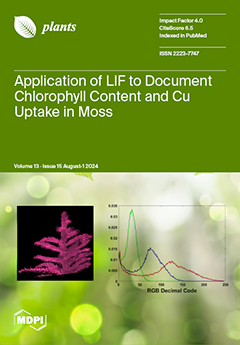Adding far-red (FR, 700–800 nm) light to photosynthetic active radiation (400–700 nm) proved to be a possible approach to increasing plant biomass accumulation for lettuce production in indoor vertical farms with artificial lighting as a sole-source lighting. However, how FR light addition influences plant growth, development, and metabolic processes and the optimal value of FR photon flux density for greenhouse-grown lettuce under sunlight are still unclear. This work aims to quantify the value of supplementary FR light with different intensities on lettuce morphological and physiological characteristics in a greenhouse. Lettuce ‘Dasusheng’ (
Lactuca sativa L.) was grown in a greenhouse under seven light treatments, including white plus red LEDs with FR photon flux density at 0, 10, 30, 50, 70, and 90 µmol m
−2 s
−1 (WR, WR + FR10, WR + FR30, WR + FR50, WR + FR70, and WR + FR90, respectively), and lettuce grown with sunlight only was marked as natural light (NL). FR light addition improved the electron transport flux per cross section and performance index (PI
abs, PI
total) and decreased the changes in relative variable fluorescence of lettuce leaves compared to plants under NL. Specifically, the PI
abs of lettuce leaves were 41%, 41%, 38%, 33%, 26%, and 25% lower under control than in plants under treatments WR + FR90, WR + FR70, WR + FR50, WR + FR30, WR + FR10, and WR, respectively. Leaf number, leaf area, and biomass accumulation of lettuce followed a quadratic function with increasing FR light intensity and were the highest under treatment WR + FR50. The shoot fresh weight and dry weight of lettuce were increased by 111% and 275%, respectively, under treatment WR + FR50 compared to NL. The contents of vitamin C, reducing sugar, total soluble sugar, and starch in lettuce showed a similar trend with biomass accumulation. In conclusion, with commonly used photosynthetic photon flux density (PPFD, 400–700 nm) around 200 μmol m
−2 s
−1, supplementary FR light intensity of 30~50 μmol m
−2 s
−1 was suggested to enhance the photochemistry efficiency, biomass accumulation, and carbohydrates’ contents in greenhouse-grown lettuce.
Full article






